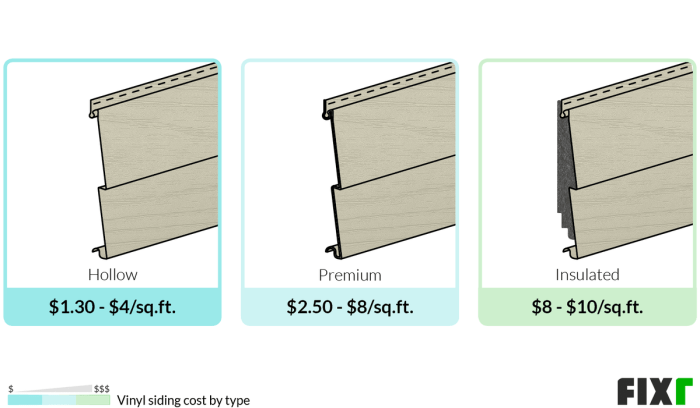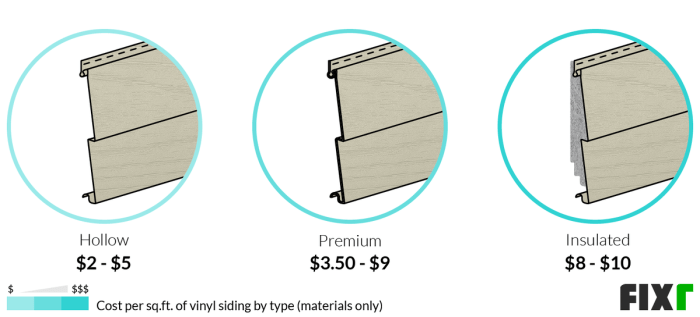Exploring the Insulated Vinyl Siding Cost Per Square Foot
Delving into the realm of insulated vinyl siding cost per square foot unveils a plethora of insights and considerations. This introductory passage sets the stage for a comprehensive exploration, offering a blend of detailed analysis and practical advice for readers seeking clarity on this crucial aspect of home improvement.
The subsequent paragraph will delve deeper into the intricacies of this topic, shedding light on key factors and comparisons to aid in informed decision-making.
Factors affecting the cost of insulated vinyl siding per square foot

When considering the cost of insulated vinyl siding per square foot, several factors come into play that can impact the overall price of the project. Let's delve into some key elements that influence the cost.
Quality of the siding material
The quality of the vinyl siding material is a significant factor in determining the cost per square foot. Higher quality materials often come with a higher price tag but may offer better durability, aesthetics, and performance. Cheaper materials may save money upfront but could result in more frequent repairs or replacements in the long run.
Size of the project
The size of the project, in terms of the total square footage of the property to be covered with insulated vinyl siding, plays a crucial role in pricing. Larger projects typically involve more materials and labor, leading to higher overall costs.
Smaller projects, on the other hand, may be more cost-effective on a per square foot basis.
Local labor costs
Local labor costs can vary significantly depending on the region and the availability of skilled professionals. Areas with higher labor costs will naturally result in higher prices for installation services, impacting the overall cost per square foot of insulated vinyl siding.
It's essential to factor in labor costs when budgeting for the project.
Additional features like insulation or textures
The inclusion of additional features such as insulation or textured finishes can also affect the cost of insulated vinyl siding per square foot. These extra elements can enhance the performance and appearance of the siding but often come at an additional cost.
Homeowners looking to invest in these features should be prepared for a higher overall price compared to basic siding options.
Comparing the cost of insulated vinyl siding with other siding materials
When considering the cost of insulated vinyl siding, it is essential to compare it with other popular siding materials to make an informed decision based on your budget and preferences.
Cost per square foot of insulated vinyl siding versus wood siding
Insulated vinyl siding is generally more cost-effective than wood siding when comparing the cost per square foot. While wood siding can range from $6 to $10 per square foot, insulated vinyl siding typically costs between $4 to $7 per square foot.
This price variation makes insulated vinyl siding a more budget-friendly option for homeowners looking to save on siding installation costs.
Cost variation between insulated vinyl siding and fiber cement siding
Fiber cement siding is known for its durability and longevity, but it comes at a higher price point compared to insulated vinyl siding. The cost of fiber cement siding can range from $5 to $12 per square foot, making it a more expensive option than insulated vinyl siding.
Homeowners on a tighter budget may find insulated vinyl siding more appealing due to its lower cost per square foot.
Differences in installation costs between insulated vinyl and metal siding
When it comes to installation costs, metal siding tends to be more affordable than insulated vinyl siding. Metal siding can cost between $4 to $8 per square foot to install, while insulated vinyl siding typically ranges from $5 to $10 per square foot for installation.
The cost variation in installation expenses may influence your decision when choosing between the two siding materials.
Maintenance expenses associated with insulated vinyl siding and brick siding
Insulated vinyl siding requires minimal maintenance compared to brick siding. While brick siding is durable, it may require periodic repointing and cleaning, which can add to the overall maintenance costs. Insulated vinyl siding, on the other hand, only requires occasional cleaning with soap and water to maintain its appearance.
This lower maintenance requirement can result in cost savings over time for homeowners who choose insulated vinyl siding over brick siding.
Calculating the total cost for a project
Estimating the total cost of a project involving insulated vinyl siding is crucial for budgeting and planning purposes. To calculate the total cost, one must consider various factors and additional expenses beyond just the cost per square foot.
Breakdown of Additional Costs
When estimating the total cost, it is essential to account for additional materials such as trim pieces, soffits, and fascia. These components are necessary to complete the siding installation and add to the overall cost of the project.
- Trim Pieces: Trim pieces are essential for finishing edges and corners, providing a polished look to the siding. The cost of trim pieces can vary based on the material and style chosen.
- Soffits: Soffits are important for ventilation and aesthetics. They help maintain airflow in the attic and contribute to the overall appearance of the home. Including soffits in the project will incur an additional cost.
- Fascia: Fascia boards are used to create a smooth, finished appearance at the edge of the roof. These boards also play a functional role in protecting the roof from water damage. Factoring in the cost of fascia boards is necessary for an accurate project estimate.
Importance of Factoring in Waste and Additional Materials
It is crucial to consider waste and the need for extra materials when calculating costs for an insulated vinyl siding project. Waste can occur during installation due to cutting errors or damaged pieces, requiring additional materials to complete the project.
Calculating an additional 10-15% for waste and extra materials is a common practice to ensure that there are enough resources to complete the project without interruptions.
Inclusion of Labor Costs
Labor costs play a significant role in the total project estimate for insulated vinyl siding. It is essential to factor in the cost of hiring professionals for the installation, as labor expenses can vary based on the complexity of the project, location, and contractor rates.
- Obtain quotes from multiple contractors to compare labor costs and choose a reputable professional within your budget.
- Consider the experience and expertise of the installers, as well as any additional services they may provide, when determining labor costs.
Tips for reducing the cost of insulated vinyl siding installation
When it comes to reducing the cost of insulated vinyl siding installation, there are several strategies homeowners can consider to make the project more budget-friendly. From negotiating with contractors to choosing cost-effective siding options, here are some tips to help lower overall expenses.
Strategies for negotiating with contractors
- Obtain multiple quotes from different contractors to compare prices and services offered.
- Ask if the contractor offers discounts for off-peak seasons or bundling services with other home improvement projects.
- Consider providing some materials or helping with prep work to reduce labor costs.
- Be clear about your budget and discuss any possible cost-saving measures with the contractor upfront.
Benefits of purchasing materials in bulk
- Purchasing insulated vinyl siding materials in bulk can often lead to discounts from suppliers.
- Buying in bulk reduces the overall cost per square foot, making it a cost-effective choice for homeowners.
- Ensure proper storage of bulk materials to prevent damage and maintain quality for installation.
Choosing cost-effective insulated vinyl siding options
- Opt for mid-range insulated vinyl siding options that offer a good balance between quality and price.
- Look for energy-efficient siding that can help reduce heating and cooling costs in the long run.
- Consider durable and low-maintenance siding options to avoid future repair or replacement costs.
Importance of proper maintenance
- Regularly clean and inspect the insulated vinyl siding to prevent damage and maintain its appearance.
- Address any issues promptly to avoid costly repairs or replacements in the future.
- Follow manufacturer's guidelines for maintenance to ensure the siding's longevity and performance.
Outcome Summary

As we wrap up our discussion on insulated vinyl siding cost per square foot, it becomes evident that this essential element of home renovation demands attention to detail and a keen eye for cost-effective solutions. The insights shared here serve as a roadmap for navigating the complexities of pricing and quality, ensuring a successful siding project with lasting benefits.
Frequently Asked Questions
What factors influence the cost of insulated vinyl siding per square foot?
The quality of the siding material, project size, local labor costs, and additional features like insulation or textures all play a role in determining the final cost.
How does the cost of insulated vinyl siding compare to other siding materials?
Insulated vinyl siding can be compared to wood siding, fiber cement siding, metal siding, and brick siding in terms of cost per square foot and installation expenses.
What is the best way to calculate the total cost for an insulated vinyl siding project?
Estimate the total cost based on square footage, factor in additional costs for trim pieces and other materials, and include labor costs in the project estimate.
Are there tips for reducing the cost of insulated vinyl siding installation?
Negotiate with contractors for lower labor costs, purchase materials in bulk, choose cost-effective siding options, and prioritize proper maintenance to extend the siding's lifespan and reduce long-term expenses.




